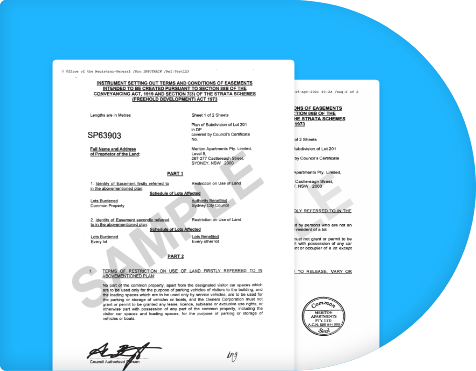Get easy access to 88B Instruments
Perform searches by address or plan number. InfoTrackGO delivers the right 88B Instrument at your convenience.
What is an 88B Instrument?
A Section 88B Instrument is a legal document that accompanies any new plan for registration. This document is specific to New South Wales only, and applies where a property easement, right, restriction or covenant is being created (or removed). Section 88B Instruments allow for the creation or release of any of the above rules and restrictions — these are attached to the property at the time of sale and the purchaser is legally bound and expected to follow these.
An easement gives the right to use part of someone else’s land for specific purposes like drainage or having a driveway.
Positive covenants require the landowner to do something, like maintaining a fence or a shared path.

When do you need an 88B Instrument?
An 88B instrument defines the parties that are benefitted and burdened, helping you to make more informed decisions regarding your properties.
How can you get an 88B Instrument?
Through InfoTrackGO’s seamless property search functionality, you can easily order and receive the 88B instrument you’re after.
All you have to do is type the address of the property in the search bar, and then we will source the document on your behalf.
It is important to note, however, that 88Bs only came into existence in the 1960s. This means that not every property has an 88B attached. If the property has no 88B, the information typically captured in an 88B instrument can often be found in the Schedule 2 of the property’s Title Certificate – a document that InfoTrackGO can also source for you.
Related Blog Post on 88B Instruments
88B Instruments FAQs
An 88b document is a subset of a deposited plan. When a new property is registered, any easements, rights, restrictions or covenants are recorded when they are created (or removed).
An 88b document will identify which parties are benefitted and/or burdened. It will also identify the terms of each easement, right, restriction or covenant listed on the property.
Not all properties will have an 88b available for them. 88b’s only came into existence in the 1960’s, so any properties created before then will not have an 88b document. Likewise, if a property has no easements, rights, restrictions or caveats listed, it will also not have an 88b.
If no 88b document is available for purchase, any information that would be listed in an 88b can often be found in Schedule 2 of a title certificate.



